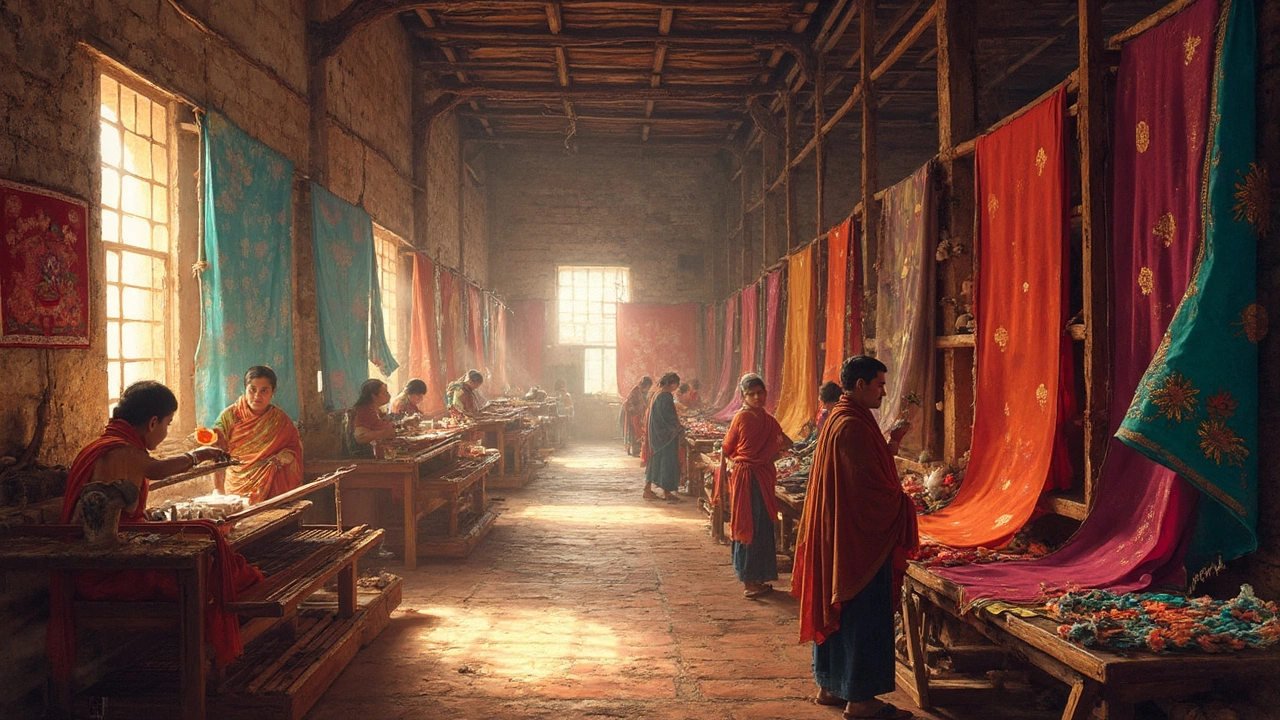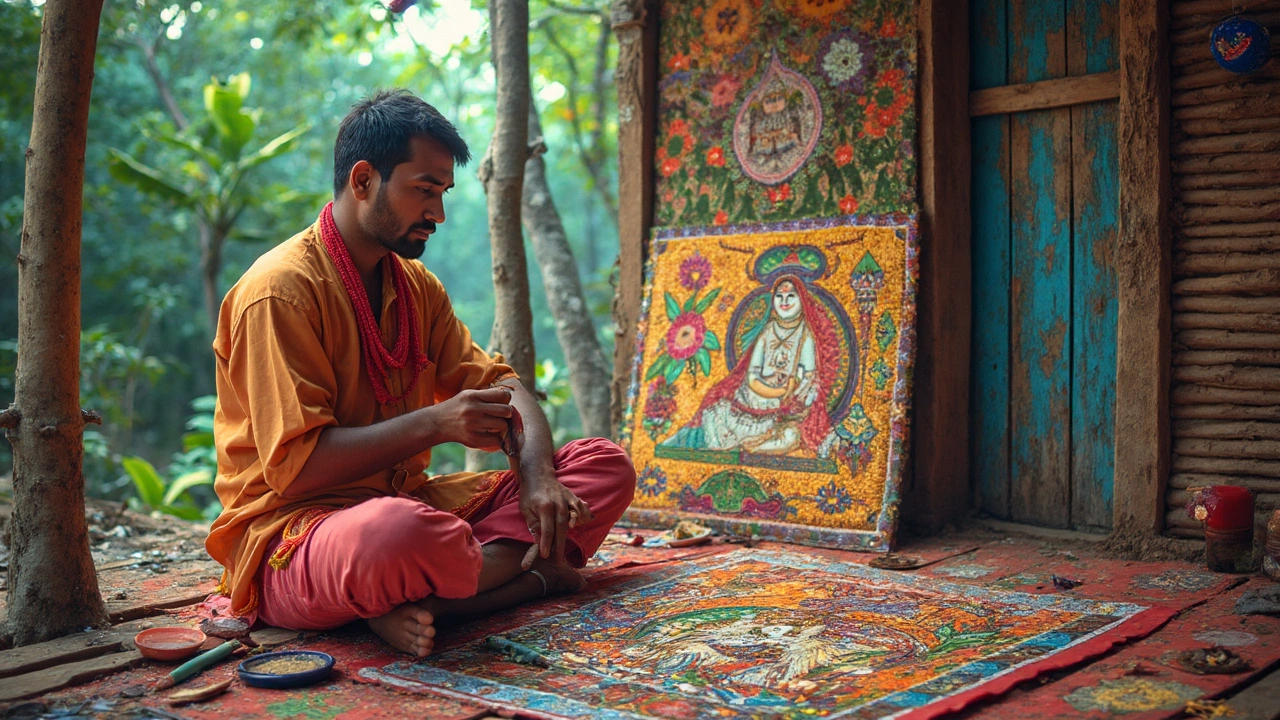India, with its kaleidoscope of cultures and traditions, cradles some of the world's most fascinating handicrafts. These crafts aren't just relics of the past; they're a living, breathing part of the country's identity, showing the true essence of Indian artistry through vibrant colors, intricate designs, and age-old techniques.
One of the first things that come to mind when talking about Indian handicrafts is Madhubani paintings. Originating from Bihar, these paintings are a riot of earthy colors and intricate patterns, often depicting religious themes or nature. They've been around for centuries but continue to captivate art lovers worldwide.
And then there's the wide range of textiles that India is famous for. Think vibrant sarees, handwoven shawls, and brilliantly embroidered dresses. Each region brings something unique to the table, like the softness of Kashmir's Pashmina or the vivid designs of Gujarat's Bandhani. These crafts aren't just beautiful; they support entire communities of artisans and keep traditional skills alive.
- The Timeless Madhubani Paintings
- Sensational Indian Textiles
- Enchanting Pottery and Terracotta
- Exquisite Jewelry Craftsmanship
- Breathtaking Woodwork and Furniture
- Marvelous Metalwork Techniques
The Timeless Madhubani Paintings
Madhubani paintings, a mesmerizing blend of vivid color and intricate detail, hail from the Mithila region of Bihar. They've been a cherished art form for centuries, originally adorning the mud walls of homes. Today, they're celebrated globally for their unique style and cultural significance.
One of the standout features of Madhubani art is its strict adherence to traditional rules. The paintings are characterized by their use of natural dyes and pigments. Artists often use household items like twigs, fingers, or even brushes made of bamboo sticks to create these stunning pieces. It's a testament to creatively using what's on hand!
These paintings primarily depict mythological themes, showcasing stories of Hindu gods and goddesses like Rama, Krishna, and Durga. Nature also plays a significant role, with motifs like fish, peacocks, and vibrant floral patterns. The designs often reflect themes of fertility, love, and prosperity, blessing the surroundings with positive vibes.
- Colors: Derived mostly from natural sources. Black might come from burnt cow dung, yellow from turmeric, and green from leaves.
- Styles: Based on the castes, with Brahmins using more religious themes and other communities incorporating nature elements.
Beyond their aesthetic appeal, Madhubani paintings are a vital source of income for many artisans in Bihar. Women, in particular, have found empowerment through this art, preserving traditions while earning livelihoods. It's a brilliant way of keeping culture and art alive, while also helping communities thrive economically. If you ever find yourself in Bihar, grabbing a piece of this art might just bring a slice of cultural heritage into your home.
Sensational Indian Textiles
When it comes to stunning art on fabric, Indian textiles are in a league of their own. With a history that stretches back thousands of years, these fabrics aren't just clothes; they're narratives woven with skill, culture, and tradition. The textile industry in India is massive, supporting millions of weavers and craftsmen who pass down their skills from generation to generation.
Let's start with one of the most luxurious fabrics, Pashmina. This wool comes from the undercoat of Himalayan goats and is known for its softness and warmth. Mostly crafted in Kashmir, a genuine Pashmina shawl is a staple for those who appreciate high-quality hand-crafted products. These shawls take weeks, sometimes months, to weave by hand, making them as rare as they are beautiful.
Another iconic textile comes from Gujarat and Rajasthan—Bandhani. This tie-dye method involves tying small parts of the fabric with threads and then dyeing it in vibrant colors. The result? Gorgeous patterns that look like they've leaped off an artist's canvas. Not only is Bandhani stunning, but it's also connected to auspicious occasions like weddings and festivals. Investing in a Bandhani saree might just add a colorful touch to your wardrobe!
Then there's Karnataka's pride, the Mysore silk saree. Known for its luxurious feel and trademark golden zari border, it's an absolute must-have in many Indian households. These sarees combine tradition and glamor, making them perfect for both everyday wear and special occasions.
Finally, let's talk about the ancient art of Block Printing. Rajasthan and Gujarat have mastered this technique, where carved wooden blocks are used to print patterns onto fabric. From intricate floral designs to geometric shapes, each piece tells a story while offering a nod to the past. Look for bedspreads or curtains made with block print to bring a touch of India into your home.
All these textiles not only celebrate India’s rich cultural diversity but also showcase strong commitment to sustainable and ethical fashion. Next time you’re out shopping, why not keep an eye out for some of these beauties? They’re not just textiles; they’re a piece of India’s soul.
| Textile | Region | Key Characteristics |
|---|---|---|
| Pashmina | Kashmir | Soft, warm, luxurious |
| Bandhani | Gujarat & Rajasthan | Vibrant, tie-dye |
| Mysore Silk | Karnataka | Luxurious, traditional zari border |
| Block Printing | Rajasthan & Gujarat | Intricate patterns, hand-crafted |
Enchanting Pottery and Terracotta
When it comes to timeless beauty and traditional wisdom, nothing quite matches the appeal of Indian pottery and terracotta art. One of the most fascinating things about these crafts is how they blend form and function. These aren't just pretty pieces to admire; they're often highly practical, forming an integral part of everyday life in many Indian households.
Take the villages of Khurja in Uttar Pradesh, for instance. Known as the 'ceramic city,' Khurja's pottery is stunningly diverse—ranging from exquisite mugs and vases to decorative tiles. You'll spot these beautiful works in homes and hotels around the world, thanks to their unique style and durability.
Another impressive craft is the terracotta work from West Bengal. In towns like Bishnupur, artisans skillfully fashion everything from intricate temple sculptures to simple pots. The reddish-brown hue of terracotta has a rustic charm that's hard to resist. And guess what? They say Bishnupur's terracotta temples have stood strong for over 500 years!
If you ever find yourself in India, visiting these artisanal hubs gives you a unique chance to see the crafting process firsthand. Artisans shape the clay with just their hands and basic tools, turning simple lumps into masterpieces over an open flame.
Why not take a piece of this tradition home? Buying direct from artisans not only gets you a special keepsake but also helps sustain their craft. Plus, it's a neat way to add some cultural flair to your living space!

Exquisite Jewelry Craftsmanship
Talk about Indian art, and you can't ignore the stunning craftsmanship that goes into making traditional jewelry. This isn't just about shiny stuff; it's a reflection of centuries-old techniques and cultural diversity. India, home to a variety of precious gems and metals, offers jewelry that's rich in variety and beauty.
From the intricate designs of Rajasthan's Kundan jewelry to the beautiful meenakari styles found in various regions, each type of Indian jewelry tells its own story. Kundan, known for its glass stones set in gold, has been charming people since the Mughal era. Imagine the royals wearing pieces that caught the sunlight just right, turning heads wherever they went.
Then there's temple jewelry from South India. Ever seen those elaborate gold ornaments on classical dancers or brides? That's temple jewelry for you. These pieces are characterized by their heavy gold construction and intricate designs resembling the sculptures found in temples.
If you're looking for something lighter, consider the colorful bead jewelry of the northeastern tribes. Made using vibrant beads and sometimes seeds, these pieces are not only unique but also eco-friendly. They're perfect for adding a pop of color to your outfit, whatever the occasion.
How about some numbers? Let's look at the impact. In India, the jewelry industry is a significant part of the economy, worth billions of dollars. It also provides jobs to thousands of artisans who carry forward these timeless traditions. When you buy an Indian piece of jewelry, you're not just purchasing an accessory; you're supporting skilled artisans and helping preserve a piece of Indian culture.
So, next time you're thinking about adding to your jewelry collection, consider the craftsmanship behind Indian styles. With a wide range of designs and techniques, there's probably a piece out there that fits your style perfectly!
Breathtaking Woodwork and Furniture
When it comes to Indian handicrafts, wooden craftsmanship stands out like a masterpiece. From finely carved sculptures to elegant furniture pieces, India's woodwork reflects its rich cultural narratives and incredible artistic flair.
One of the most celebrated places in India for woodwork is Saharanpur in Uttar Pradesh. This town is famous for its intricate wooden carvings, often referred to as the finest in the country. Craftsmen here use Sheesham wood, also known as Indian Rosewood, to create everything from simple household items to elaborate furniture pieces.
Then there’s the Kashmir region, where woodwork is intricately linked with walnut trees. Here, you'll find beautifully carved tables, chairs, and decorative items. The walnut wood carving from this region is particularly valued for its fine detailing and durability.
If you are exploring other regions, don’t miss the traditional art of sandalwood carving from Karnataka. Artisans here intricately transform scented wood into exquisite figurines and detailed panels, which have even caught the eyes of global collectors. Plus, who can forget West Bengal’s canework and Assam’s bamboo creations, which offer sustainable, light, and beautiful solutions to furniture needs?
Here's a quick glance to give you an idea about the standout styles in Indian woodwork:
- Saharanpur, Uttar Pradesh: Known for Sheesham wood carvings.
- Kashmir: Famed for walnut wood furniture.
- Karnataka: Specializes in sandalwood carvings.
- West Bengal & Assam: Noted for cane and bamboo furniture.
Besides their aesthetic appeal, these crafts provide employment to thousands of artisans across the country. So, buying or appreciating these works isn't just about owning a piece of art; it's about supporting a legacy that's been perfected over generations.
Marvelous Metalwork Techniques
When it comes to Indian art, metalwork is nothing short of extraordinary. This ancient craft is as much about function as it is about form, and it's been an essential part of Indian culture for ages. Whether it's the stunning jewelry, the grand statues, or the detailed utensils, Indian metalwork is an art form that mixes precision with creativity.
The most well-known type of metalwork from India has to be the Dhokra art, which uses a lost-wax casting technique. This method has been around for over 4,000 years! Artisans from West Bengal and Madhya Pradesh mold wax into intricate designs before covering them with clay to create these stunning sculptures.
Then there’s Kansa work from Odisha, made from an alloy of copper and tin. These utensils are not only beautiful but also are said to possess health benefits. If you've ever wandered through a market in Odisha, you might have come across a Kansa thali—a whole dining set crafted from metal.
You can't talk about Indian handicrafts without mentioning Brass and Copper crafts. From lamps to decorative pieces, the states of Uttar Pradesh and Rajasthan are famous hubs for these crafts. The hammered designs and motifs showcased on the products show off the exceptional skills of the artisans.
| State | Metalwork Type | Specialty |
|---|---|---|
| Odisha | Kansa | Utensils and Plates |
| Bihar | Dhokra | Sculptural Art |
| Uttar Pradesh | Brass | Lamps and Home Decor |
So, why does this matter? Supporting these crafts ensures these age-old techniques don't vanish into oblivion. Plus, owning a piece of Indian metalwork is like having a slice of history in your own home. Basically, it's art with a story—not just something that looks pretty on a shelf.
